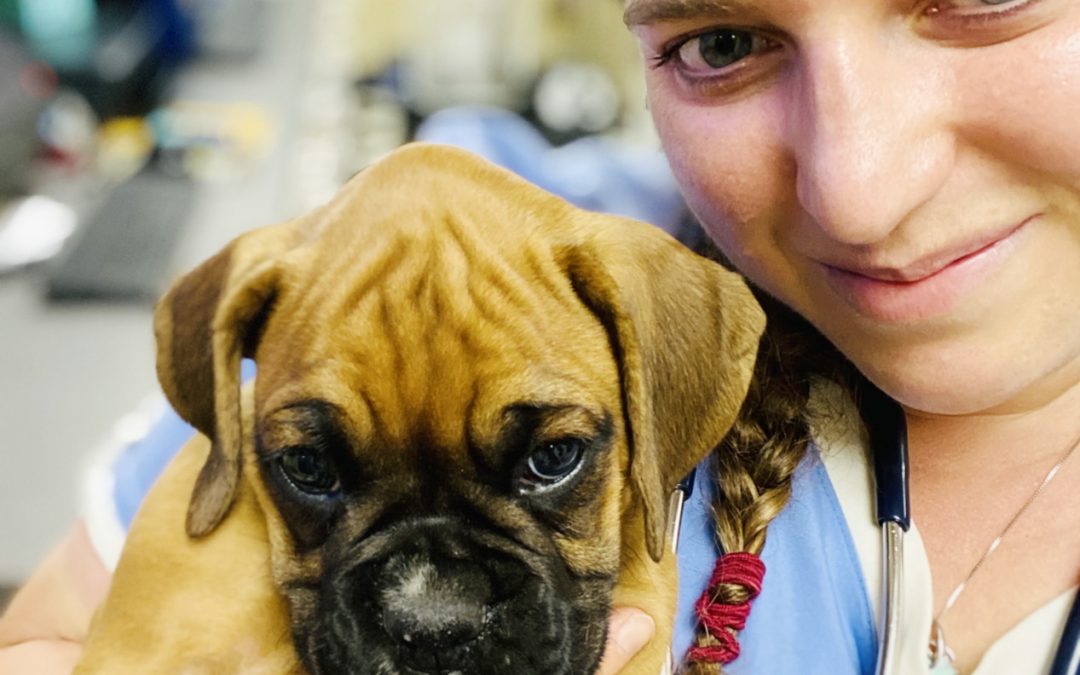By ROBERTA CANNON
When I rescued my dog Finnigan, a Boston Terrier mix, 12 years ago, I stocked up on the essentials such as pet toys, a crate, treats, collar, leash, food and a dog bed. He tore the toys apart, loved his treats, and while the dog food took some experimenting to get it right for his sensitive stomach, he settled into his new home after overcoming a few challenges.
He was longer-legged than the average Boston Terrier, which made him tall when he stood on his hind legs. He discovered how to use his height to his advantage when one day he pulled a loaf of bread off a ceramic-topped table in the kitchen and ate it. I came home to discover an empty plastic bag on the floor and his stomach in the shape of a loaf of bread. My kids nicknamed him “loafie.”
While ingesting a loaf of bread was harmless and certainly not the end of his investigative prowess, although a gift of Cape Cod Coffee ended up strewn throughout the house one Christmas morning, we were lucky that his antics didn’t harm him.
I was surprised to learn that these kinds of animal adventures are a number one concern for winter illnesses. When I spoke with Lindsay Hirt, a veterinary technician and marketing coordinator for Leach Animal Hospital in Mashpee, about getting our pets ready for winter, she explained that while there aren’t any disease-spreading illnesses related to winter, there are illnesses due to holiday “shenanigans.”
“There are many celebrations, holiday gift giving and rich foods. We see toxicity related to chocolate, foreign bodies in dogs that eat entire turkey carcasses when left on the counter, we see pancreatitis with animals that get a little bit of filet mignon at Christmas dinner and animals who run away, get injured or are never found,” Ms. Hirt said.
They can get into presents, drink the water that may contain fertilizer out of the Christmas tree stand. “We see a lot of dogs with vomiting/diarrhea from drinking the water,” said Ms. Hirt. They can also tear gift baskets apart and eat the contents, resulting in foreign bodies in their stomach.
“A key piece to winter preparations is being very careful and keeping in mind that company, rich food and decorations, which are wonderful for us, pose risk and injuries to animals,” Ms. Hirt said. She explained that the chaos of company, changes in schedules and parties can be very stressful for the animals.
Other Dangers
Other perils to be aware of are ice, de-icers, and the accidental ingestion of antifreeze.

ROBERTA CANNON
Cassie Marischen, owner of Tails in the Sand
“Animals suffer from falls on the ice,” Ms. Hirt said. “This is particularly hard on senior pets who have a much tougher time with traction because of weakness, muscle atrophy and arthritic conditions.”
While there are pet de-icers for walkways and stairs, not many people use them, according to Ms. Hirt. “We sometimes see chemical burns on paws,” she said. “Also, dogs that have very fluffy pads or a lot of fur between their toes will lick the salt and de-icer in their pads when they come into the house and cause gastrointestinal symptoms. We always recommend pet de-icer on your own stairs if you have pets coming in and out but when you can’t do that, brush off your pet’s feet. You can soak them in warm water or wipe them off with a damp cloth, removing any de-icer.”
Ms. Hirt said the clinic doesn’t see a lot of cases of antifreeze ingestion because Cape Cod pet owners are very aware and well-informed. “Overall, antifreeze toxicity is very common, and the reason why is the chemical ethylene glycol is toxic and tastes very sweet for a very long time,” said Ms. Hirt. “It is very attractive to dogs, cats and wildlife until they lick for quite a bit, and it starts to have a yucky aftertaste. By the time that happens, it becomes toxic.”
The toxicity affects the brain, liver and kidneys and can quickly become severe. Symptoms can include diarrhea, vomiting, seizure, coma, ataxia and kidney failure. If your animal has ingested antifreeze, get in touch with your veterinarian immediately and call poison control for treatment instructions. Animal poison control center is available 24/7, and the number is 855-764-7661. Be aware they do charge a fee. The ASPCA animal poison control number is 888-426-4435. There may be a consultation fee.
Prevention is key, and Ms. Hirt recommends keeping lids on antifreeze containers closed, store them away from pets and children, check your car for leaks, repair them, and don’t let your puppy, cat or dog wander unattended in garages, roadways or driveways. Also, be aware that summer cottages often have antifreeze in their toilets when closed for the winter months, and some dogs can have accidental ingestion from drinking the water from the toilet.
Weather Changes And
Prevention Questions
What is the best way to acclimate your pets from fall into winter?
“There is no special way to acclimate dogs and cats to winter,” said Ms. Hirt. “They are so domesticated here in New England because they are largely indoors.” She recommends that owners avoid extreme temperature changes. “Don’t have your dog inside with the heat on and then take them outside for two to three hours when it’s eight degrees out and a huge windchill. Take them for short frequent walks so they can get used to the air, humidity and temperature difference.”
Do dogs need to wear a coat or sweater in the winter?
Many dogs, such as golden retrievers, Labrador retrievers, Samoyeds, Samoans and Huskies, are well-equipped to acclimate to winter temperatures and never need a coat. Small, hairless or highly groomed breeds such as Shih Tzus, mini-poodles, Chinese crested or a four-pound chihuahua can wear a coat or sweater. She cautions owners to make sure to remove them once they are inside because their skin needs to breathe.
“In the vet clinic, we see a lot more clothing than is necessary and oftentimes owners don’t realize their small furry dogs are very hot or very matted.” She explained further that when dogs have matted coats, it is harder for them to regulate their temperature. The number one priority is to make sure they are well-groomed.
Do dogs need to continue preventative medications through the winter?
Owners should continue preventative medication for heartworm, which is spread by mosquitoes, throughout the winter. Flea and tick preventatives should also be continued year-round.
“Prevention is much more effective than repellant for fleas and ticks, as it acts as a killer of the parasite and can stop the cycle of reproduction,” Ms. Hirt said. “Repellants only act as a deterrent and, if unevenly applied, the animal goes swimming or has sun exposure, the parasites can still make their way onto the pet’s skin and jump off onto humans. However, they can be useful for pets that may have allergies to topical prevention products or are unable to be given an edible chew or wear a prevention collar.”
A Shop To Help With Your
Pet’s Winter Needs
A visit to Tails in the Sand in Sandwich, owned by Cassie Marischen and Jim Redman, will accommodate your pet’s needs for the winter, and your dog can even accompany you to help with the shopping. Ms. Marischen is more than happy to assist you, your canine and feline family members with her recommendations for products and items you may need.
“We have treats, toys, collars, leashes, harnesses and other everyday supplies, including bowls, beds and foods for dogs and cats,” Ms. Marischen said.
The assortment of baked goods includes biscuits and jerkies that are high-quality treats and made in the United States. “The cookies, cupcakes and biscuits are from a local dog bakery,” said Ms. Marischen.
She also carries a variety of natural flea and tick repellants. “The sprays are really popular because you can use it on your dog and yourself as well,” she said. “They all contain essential oils that insects don’t like, so it repels them. They work on ticks, fleas, flies and beetles.” She also has chemical and pesticide flea and tick products such as Soresto and Canine Advantix for owners who have those preferences.
Shampoo products include a foam shampoo and daily grooming wipes that can be used without water, which is especially helpful if you have a large dog that you would normally bathe outside in the warmer months. “The wipes can be used to remove the ice melt on paws and help remove the snow between the toes,” Ms. Marischen said.
Some items that drew my attention were the various Velcro strap bowties available in a multitude of colors and themes and the colorful coats and sweaters. The pet alert decals to stick on your window at home, alerting emergency personnel there is a pet inside the house especially if no one is home, is another great item.
Winter weather will be upon us sooner than we realize, and it helps to know there are many preventative approaches we can take to keep our pets safe. This includes advice and recommendations from our veterinarians as well as shops like Tails in the Sand to assist with whatever products we need to keep our animals healthy, warm and well-nourished.

